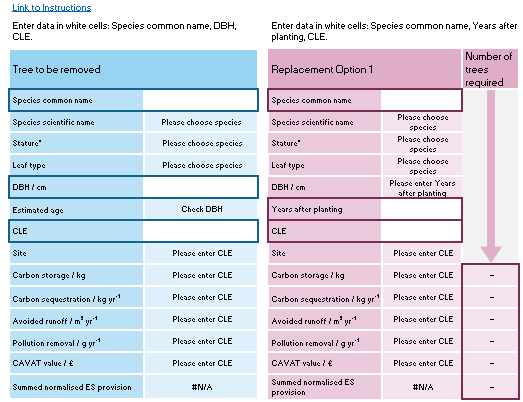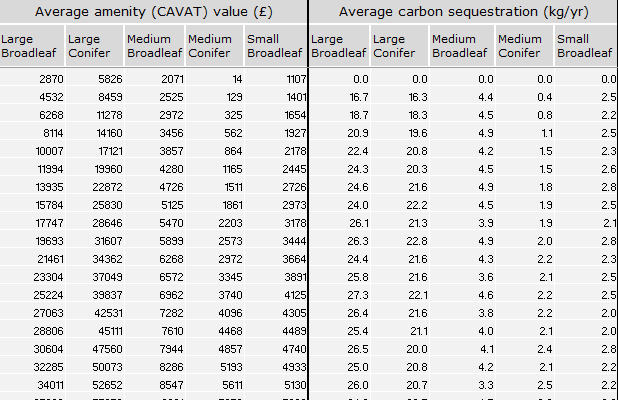Summary
Urban trees provide benefits or ecosystem services to people. The size, condition, and species of urban trees determine their ability to provide these benefits.
To guide species selection for new urban planting, and to calculate replacement rates for trees removed from urban areas, it helps to understand:
- the relative differences in benefit delivery of small, medium and large stature trees,
- how benefit delivery varies within these stature groups, and
- how benefits change over time, including how long it takes provision to peak.
Research Objectives
The aim of this work is to help inform species selection for urban tree planting programmes as part of a right tree right place approach, and to support decision-making on the appropriate numbers of tree replacements required following the removal of a tree.
Findings and Recommendations
Forest Research In Brief No. 1: Selecting urban trees for ecosystem service provision
This In Brief note brings together and develops further the results of two research reports, and an overarching Research Note:
Ecosystem services delivery by large stature urban trees
Ecosystem services delivery by small and medium stature urban trees
Understanding the role of urban tree management on ecosystem services
New calculations of annual ecosystem service provision by a selection of urban trees provide greater clarity for species selection and enables calculations to support tree replacement rates.
This work highlights the role of larger trees in providing greater benefits than smaller and shorter-lived counterparts, even over short time frames.
It also finds that trees planted in open locations provide greater levels of benefit compared to those in more enclosed settings.
General Content
How to use this work
The In Brief note and supplementary material (available in the Download section, below) provide provision of carbon storage, carbon sequestration, pollution removal, and avoided runoff by 30 urban tree species over 100 years.
The replacement rates workbook (available in the Download section, below) enables users to calculate how many urban trees should be planted to replace ecosystem service provision lost through removal of urban trees, and can inform species selection for new planting based on ecosystem service provision.
The methodology, assumptions, references and further resources are given at the bottom of this page.
Downloads

Selecting urban trees for ecosystem service provision
Forest Research In Brief No 1.

Selecting urban trees for ecosystem service provision. Supplementary Material.

Ecosystem service provision workbook
Excel workbook for calculating replacement of ecosystem service provision by urban trees

Supplementary data (Excel workbook)
Ecosystem service provision data over 100 years for stature and leaf type groups
Methodology
Thirty trees species common to UK towns were categorised by stature: small, medium, large1,2, and leaf type: conifer, broadleaf. For each species, tree size was estimated over a 100-year period using growth rates from the literature averaged for each stature and leaf type.
A tree’s total carbon storage, gross annual carbon sequestration, annual avoided stormwater runoff and annual air pollution removal contributions were estimated using i-Tree Eco3 for each species over 100 years. Trees were modelled in three location types: open (no over shading), semi-open (over shadowing on 2 sides) and enclosed (overshadowing on each side and from above) by using the i-Tree Eco Crown Light Exposure values of 5, 3 and 1, respectively.
Amenity value of trees was estimated using the CAVAT full method4.
Lifespan was assumed to be 80 years for small stature trees, 150 years for medium stature, and over 200 years for large stature. Trees were estimated to be planted at age seven, with a one-year lag (no growth) phase post-planting.
Ecosystem service values were normalised to aid comparison: with a maximum value of 1 and minimum value of 0.
Assumptions
Ecosystem service provision by any one tree will be influenced by its regional climate, location, health, growth rate and lifespan.
Trees were modelled in the same region, land-use type and under constant condition levels to ensure comparability; benefit provision is, therefore indicative, only.
This work only considers four ecosystem services; urban trees also provide a wide range of other benefits including cultural, wellbeing and biodiversity services5.
Growth of trees is modelled based on average growth rates for their stature group. Species may have faster or slower growth rates, which would affect their ecosystem service provision.
References
- Hand, K., Doick, K. & Moss, J. (2019). Ecosystem services delivery by small and medium stature urban trees. Forest Research.
- Hand, K. L., Doick, K. J. & Moss, J. L. (2019). Ecosystem services delivery by large stature urban trees. Forest Research.
- Nowak, D. J., Crane, D. E., Stevens, J. C., Hoehn, R. E., Walton, J. T., & Bond, J. (2008). A Ground-Based Method of Assessing Urban Forest Structure and Ecosystem Services. Arboriculture & Urban Forestry, 34, 347–358.
- Doick, K. J., Neilan, C., Jones, G., Allison, A., McDermott, I., Tipping, A. & Haw, R. (2018). CAVAT (Capital Asset Value for Amenity Trees): valuing amenity trees as public assets. Arboricultural Journal, 40, 67–91.
- Davies, H. J., Doick, K., Handley, P., O’Brien, L. & Wilson, J. (2017). Delivery of ecosystem services by urban forests. Forestry Commission.
More Resources
Information presented on this page complements guidance including the Urban Tree Manual, TDAG’s guide to urban tree species, and the Forestry Commission’s Right Trees for a Changing Climate and should be used in conjunction with these resources.
Barbook, J., Mackenzie, R., Doick, K. J., Griffiths, A., Salisbury, A. & Smith, J. C. (2018) Urban tree manual. Forest Research.
Britt, C. & Johnston, M. Trees in Towns II. A new survey of urban trees in England and their condition and management. (Department for Communities and Local Government, 2008).
Forestry Commission. Right trees for a changing climate. Available at: http://www.righttrees4cc.org.uk/.
Gilbertson, P. & Bradshaw, A. D. (1990). The survival of newly planted trees in inner cities. Arboricultural Journal, 14, 287–309.
Hirons, A. & Sjöman, H. (2019). Tree Species selection for Green Infrastructure. A guide for Specifiers. Trees & Design Action Group.
Smith, J. (2021). The Mayor’s Street Tree Programme Final Evaluation Report. Forestry Commission for Mayor of London.
Vaz Monteiro, M., Handley, P. & Doick, K. J. (2019). An insight to the current state and sustainability of urban forests across Great Britain based on i-Tree Eco surveys. Forestry, 1–17.
